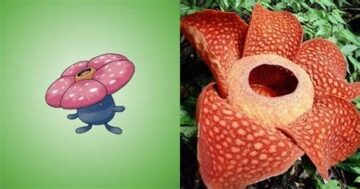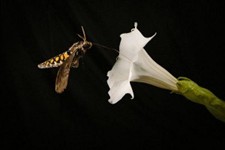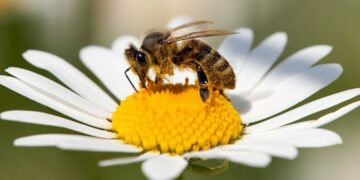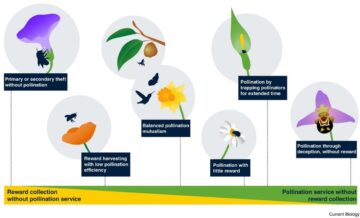by Thomas Fernandes

We might know more about biodiversity than ever before, yet we see it less. When life is talked about as “carbon sinks,” “pollinator services,” or “extinction curves,” it flattens into numbers: computable but unfeeling. But the loss we face isn’t just biological. It’s perceptual. We no longer notice life. Our first loss, then, may not be biodiversity itself, but our ability to see it. And nowhere is this blindness more widespread, or more foundational, than with plants.
Plant blindness is not simply a lack of interest in flora but a systemic failure to perceive the living structure of the world around us. We might pause for a flower’s scent or color, but how often do we notice the complex strategies behind its form?
Let’s begin, then, not with the abstract notion of biodiversity, but with the particular of flowering plants. At first, they had no roots, relying on fungi to supply water and nutrients in exchange for sugars produced by the plant through photosynthesis. With time plants started to develop their own roots systems but still lacked flowers. They were mostly ferns and conifers like pines.
In a baffling new evolution angiosperm (flowering plants) appeared about 170 million years ago. Flowers are the product of natural selection to attract and use pollinators to reproduce. They use scent, color, shape and sometimes temperature to signal to pollinators. Smell for instance is a primary attractor for many pollinators. In Europe, flowers that rely on bees and butterflies often emit sweet scents. But not all strategies are pleasant to us.
The Rafflesia, the world’s largest flower, smells like rotting meat to attract flies. The Titan Arum goes further, heating itself to human body temperature to volatilize more effectively corpse smelling compounds detectable hundreds of meters away. The temperature also imitates that of a body, an attractor in itself for carrion beetles.
On the pollinator side each species is sensitive to certain smell that provides the best food. In a way we could compare it to how we evolved to like sugar and fat which are also some of our most efficient food sources. Plants also adapted their visual cues to the vision of their pollinators, often insects.

Insect vision is shifted toward ultraviolet, which they can perceive, while they cannot perceive red. The overlap with our vision is good enough that we find most flower good looking but we do not see them like their targeted audience sees them. Yet another thing that we do not see and do not suspect of existing. I encourage you to look to UV illuminated flowers to be able to see it. You will often see flowers following some kind of bullseye pattern helping insects locate the point of interest for pollinator that will feed on nectar or pollen.

Shape is not random. If you evolved for humming birds or hawk moth a tubular shape will fit their feeding appendices and ensure contact with pollen that will deposit in the next flower they visit.
Flowers like daisies provide landing platforms for general pollinator like bees but the landing ground is conveniently full of pollen. Daisies being composite flowers, each little yellow dot that you see in the picture below is actually its own flower, meaning that the bees is already pollinating the flower by walking across.

Some relationships become highly specialized. Yucca plants and yucca moths have co-evolved to the point of mutual dependence. The female moth gathers pollen from one plant, fly to another flower and will lay its egg and insert the pollen into the stigma. This is basically deliberate pollination! The growing seeds will feed the larvae so the moth is actually feeding her children via the pollen transfer. The yucca plant will abort fruits with too many eggs forcing the moth to reduce the number of eggs and choosing only unused plants to lay her eggs. And so, the equilibrium is maintained. This degree of coordination, the subtle cues and interactions is what we are missing.
These are not passive life forms. Plants respond to threats, release signals, adjust their emissions, and manage their energy. Some flowers bloom at night to attract nocturnal pollinators. Some like daisies rather close at night by folding back its petals to protect against nocturnal visits. Others, like the Queen of the Night cactus, flower only once a year, for one night (time lapse here ). Still others change color after pollination to discourage further visits, like the lantana flower.
The story of plants is a story of trade-offs, and evolutionary improvisation. When attacked by herbivore feeding on them some plants can emit scents to attract predators of those herbivores. Carnivorous plants are an evolution to access nitrogen and phosphor in animals when lacking in the ground. The Venus flytrap for example produce nectars and smells only to attract preys that, upon touching two different trigger hair within twenty seconds, will spring the trap shut and start the digestion process.
Some strategies are deceptive. The “bee orchid” simulate a female bee in appearance and smell by emitting the same pheromones to that of female bee. The targets are solitary bees’ species that are tricked into attempted mating with the flower and in doing so, spread the pollen. This is a net loss for the bees but saves energy for the orchid that does not produce nectar.

Seed dispersal is strategic too. For peppers their seed can be crushed or harmed by mammals eating them but not by birds. In response different capsaicin levels are correlated to the amount of mammal presence near different pepper species. Capsaicin activates the mammal receptor (TRPV1) that causes a burning sensation that you probably have all experienced. Birds however have no such receptor and feel no burn at all. Once again, we might feel the burn but do not see the message nor care about the reason. Another use of capsaicin for peppers is as an antifungal agent that would serve to preserve the seeds form fungi.
Some have evolved quite ingenious strategies, like the Sandbox tree aka dynamite tree. Its fruit pods are designed like a sort of catapult. As the shell dries, it contracts, building up tension until it suddenly bursts. The explosion sends pieces of fruit and seeds hurtling tens of meters at speeds over 200 kilometers per hour. Surprising strategy, but why ? Seed dispersal is key to expend and to make sure offsprings are not competing for resources by staying to close together or from the parent tree. Indeed, the launch angle of the seed was found to be optimized for maximum horizontal distance. The mechanism itself is a natural timer that will ensures seeds are disperses during the dry season under high heat. This is very reliable timing to optimize seed dispersion to an appropriate growth climate. Many other plants will showcase such adaptation. The jack pine has cones sealed in a resin that melts at high temperature. The cones will stay shut until a fire passes through, removing plant competition, melting the resin and providing a fertile soil for the freshly released seeds.
To restore vision is not only to ‘know more’ but to learn how to look differently. If we could smell a wild rose scent, we would realize how our commercial genetic selection tampered it. If we could not only see but observe a snapdragon long enough, we would realize how the flower is making itself accessible only to the strongest insects that can open them. If we could blow a dandelion, we could marvel at the flying seed witnessing the result of a supporting pappus creating a local vortex to carry seeds further aways and adjusting for climatic conditions. Knowing most of what we see is here for a reason we might begin to look for it and unlearn our blindness.
The next essay will look more closely at the honeybee, a creature so familiar that we risk failing to see it too.
***
Enjoying the content on 3QD? Help keep us going by donating now.
